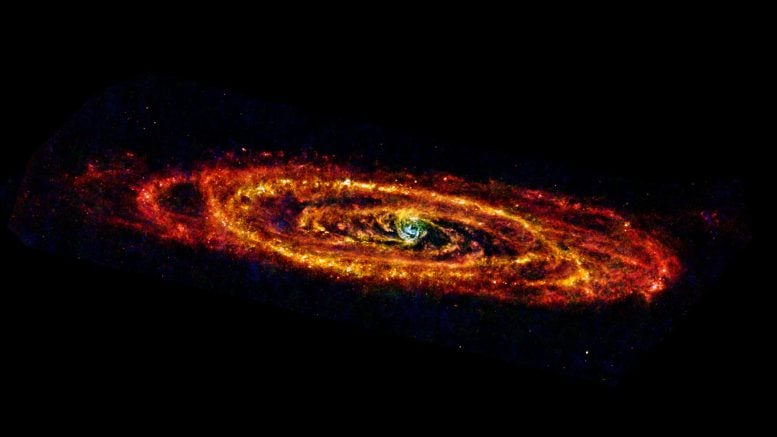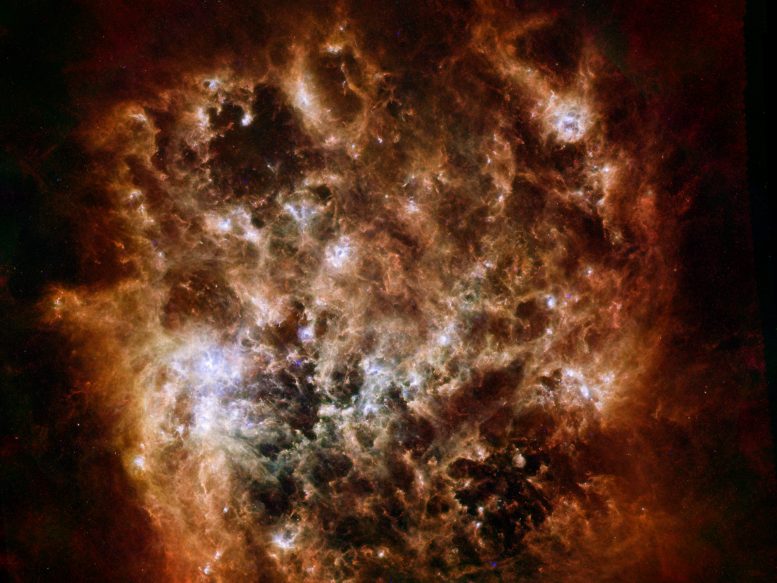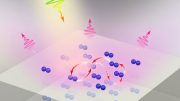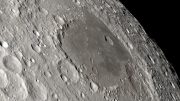
In this view of the Andromeda galaxy from the Herschel space observatory, cool lanes of forming stars are revealed in the finest detail yet. Herschel is a European Space Agency mission with important NASA participation. Andromeda, also known as M31, is the nearest major galaxy to our own Milky Way at a distance of 2.5 million light-years, making it an ideal natural laboratory to study star formation and galaxy evolution. Sensitive to the far-infrared light from cool dust mixed in with the gas, Herschel seeks out clouds of gas where stars are born. The new image reveals some of the very coldest dust in the galaxy – only a few tens of degrees above absolute zero – colored red in this image. By comparison, warmer regions such as the densely populated central bulge, home to older stars, take on a blue appearance. Intricate structure is present throughout the 200,000-light-year-wide galaxy with star-formation zones organized in spiral arms and at least five concentric rings, interspersed with dark gaps where star formation is absent. Andromeda is host to several hundred billion stars. This image of it clearly shows that many more stars will soon to spark into existence. Credit: ESA/Herschel/PACS & SPIRE Consortium, O. Krause, HSC, H. Linz
Launched roughly four years ago, the Herschel space telescope has run out of liquid coolant and has stopped making observations.
The Herschel observatory, a European space telescope for which NASA helped build instruments and process data, has stopped making observations after running out of liquid coolant as expected.
The European Space Agency mission, launched almost four years ago, revealed the universe’s “coolest” secrets by observing the frigid side of planet, star and galaxy formation.
“Herschel gave us the opportunity to peer into the dark and cold regions of the universe that are invisible to other telescopes,” said John Grunsfeld, associate administrator for NASA’s Science Mission Directorate at NASA headquarters in Washington. “This successful mission demonstrates how NASA and ESA can work together to tackle unsolved mysteries in astronomy.”
Confirmation the helium is exhausted came today, at the beginning of the spacecraft’s daily communication session with its ground station in Western Australia. A clear rise in temperatures was measured in all of Herschel’s instruments.
Herschel launched aboard an Ariane 5 rocket from French Guiana in May 2009. NASA’s Jet Propulsion Laboratory in Pasadena, California, built components for two of Herschel’s three science instruments. NASA also supports the U.S. astronomical community through the agency’s Herschel Science Center, located at the California Institute of Technology’s Infrared Processing and Analysis Center in Pasadena.

This image shows the Large Magellanic Cloud galaxy in infrared light as seen by the Herschel Space Observatory, a European Space Agency-led mission with important NASA contributions, and NASA’s Spitzer Space Telescope. In the instruments’ combined data, this nearby dwarf galaxy looks like a fiery, circular explosion. Rather than fire, however, those ribbons are actually giant ripples of dust spanning tens or hundreds of light-years. Significant fields of star formation are noticeable in the center, just left of the center, and at right. The brightest center-left region is called 30 Doradus, or the Tarantula Nebula, for its appearance in visible light. The colors in this image indicate temperatures in the dust that permeates the Cloud. Colder regions show where star formation is at its earliest stages or is shut off, while warm expanses point to new stars heating surrounding dust. The coolest areas and objects appear in red, corresponding to infrared light taken up by Herschel’s Spectral and Photometric Imaging Receiver at 250 microns, or millionths of a meter. Herschel’s Photodetector Array Camera and Spectrometer fills out the mid-temperature bands, shown here in green, at 100 and 160 microns. The warmest spots appear in blue, courtesy of 24- and 70-micron data from Spitzer. Credit: ESA/NASA/JPL-Caltech/STScI
Herschel’s detectors were designed to pick up the glow from celestial objects with infrared wavelengths as long as 625 micrometers, which is 1,000 times longer than what we can see with our eyes. Because heat interfered with these devices, they were chilled to temperatures as low as 2 kelvins (minus 271 degrees Celsius, or 456 Fahrenheit) using liquid helium. The detectors also were kept cold by the spacecraft’s orbit, which is around a stable point called the second Lagrange point about 930,000 miles (1.5 million kilometers) from Earth. This location gave Herschel a better view of the universe.
“Herschel has improved our understanding of how new stars and planets form, but has also raised many new questions,” said Paul Goldsmith, NASA Herschel project scientist at JPL. “Astronomers will be following up on Herschel’s discoveries with ground-based and future space-based observatories for years to come.”
The mission will not be making any more observations, but discoveries will continue. Astronomers still are looking over the data, much of which already is public and available through NASA’s Herschel Science Center. The final batch of data will be public in about six months.
“Our goal is to help the U.S. community exploit the nuggets of gold that lie in that data archive,” said Phil Appleton, project scientist at the science center.
Highlights of the mission include:
- Discovering long, filamentary structures in space, dotted with dense star-making knots of material.
- Detecting definitively, for the first time, oxygen molecules in space, in addition to other never-before-seen molecules. By mapping the molecules in different regions, researchers are learning more about the life cycles of stars and planets and the origins of life.
- Discovering high-speed outflows around central black holes in active galaxies, which may be clearing out surrounding regions and suppressing future star formation.
- Opening new views on extremely distant galaxies that could be seen only with Herschel, and providing new information about their high rates of star formation.
- Following the trail of water molecules from distant galaxies to the clouds of gas between stars to planet-forming solar systems.
- Examining a comet in our own solar system and finding evidence comets could have brought a substantial fraction of water to Earth.
- Together with NASA’s Spitzer Space Telescope, discovering a large asteroid belt around the bright star Vega.
Other findings from the mission include the discovery of some of the youngest stars ever seen in the nearby Orion “cradle,” and a peculiar planet-forming disk of material surrounding the star TW Hydra, indicating planet formation may happen over longer periods of time than expected. Herschel also has shown stars interact with their environment in many surprising ways, including leaving trails as they move through clouds of gas and dust.









So was the $100 million + plus worth 4 years of pictures? I do not see much “bang” for the buck here except to a specific few people who might be interested..That $100 million could have gone a long way in helping at lot more people here on earth than it did…I’d rather have seen that $100 million go into building a real Space Station or Space Port instead of the assortment of tin cans that is up there now.
I realize that $100 million in space research seems like a high figure, but consider it is no higher than what we spend on football players, race cars and for movies about (guess what?) space. Who we are, how we got here and where we are going is a great discussion for all of humanity. It touches science, religion, politics, entertainment and yes, even sports.
Where do you think the money was spent? You figure they stuffed that launch rocket with thousand pound notes? You don’t suppose the thousands of workers in the background of that project were working for free do you? Or the money the companies made that paid taxes to the government?